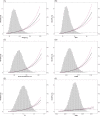Comparison of six anthropometric measures in discriminating diabetes: A cross-sectional study from the National Health and Nutrition Examination Survey
- PMID: 35841213
- PMCID: PMC9310044
- DOI: 10.1111/1753-0407.13295
Comparison of six anthropometric measures in discriminating diabetes: A cross-sectional study from the National Health and Nutrition Examination Survey
Abstract
Background: Traditional anthropometric measures, including body mass index (BMI), are insufficient for evaluating the risk of diabetes. This study aimed to evaluate the performance of new anthropometric measures and a combination of anthropometric measures for identifying diabetes.
Methods: A total of 46 979 participants in the National Health and Nutrition Examination Survey program were included in this study. Anthropometric measures, including weight, BMI, waist circumference (WC), waist-to-height ratio (WtHR), conicity index (CI), and A Body Shape Index (ABSI), were calculated. Logistic regression analysis and restricted cubic splines were used to evaluate the association between the anthropometric indices and diabetes. The receiver operating characteristic (ROC) curve analysis was performed to compare the discrimination of different anthropometric measures.
Results: All anthropometric measures were positively and independently associated with the risk of diabetes. After adjusting for covariates, the per SD increment in WC, WtHR, and CI increased the risk of diabetes by 81%, 83%, and 81%, respectively. In the ROC analysis, CI showed superior discriminative ability for diabetes (area under the curve 0.714), and its optimum cutoff value was 1.31. Results of the combined use of BMI and other anthropometric measures showed that among participants with BMI <30 kg/m2 , an elevated level of another metric increased the risk of having diabetes (P < .001). Similarly, at low levels of weight, CI, and ABSI, an elevated BMI increased diabetes risk (P < .001).
Conclusions: WtHR and CI had the best ability to identify diabetes when applied to the US noninstitutionalized population. Anthropometric measures containing WC information could improve the discrimination ability.
目的: 包括体重指数(BMI)在内的传统人体测量方法不足以评估糖尿病的风险。这项研究旨在评估新的人体测量方法和人体测量方法的组合在识别糖尿病方面的表现。 材料和方法: 本研究共纳入46979名参加国家健康与营养调查项目的受试者。计算人体测量指标,包括体重、BMI、腰围(WC)、腰高比(WtHR)、圆锥度指数(CI)和身体形态指数(ABSI)。使用Logistic回归分析和限制三次样条法评估人体测量指标与糖尿病之间的关系。对受试者工作特征(ROC)曲线进行分析,比较不同人体测量指标的识别率。 结果: 所有人体测量指标均与糖尿病风险呈正相关且独立相关。校正协变量后,WC、WTHR和CI的每标准差增量分别使糖尿病风险增加81%、83%和81%。在ROC分析中,CI对糖尿病具有较好的鉴别能力(曲线下面积为0.714),其最佳临界值为1.31。体重指数和其它人体测量指标的联合使用结果显示,在BMI<30kg/m2 的参与者中,另一项指标的升高增加了患糖尿病的风险(P<0.001)。同样,体重、CI和ABSI值较低时,BMI升高会增加患糖尿病的风险(P<0.001)。 结论: 在美国非住院人群中,WtHR和CI识别糖尿病的能力最强。包含WC信息的人体测量指标可以提高辨别能力。.
Keywords: anthropometry; conicity index; diabetes mellitus; obesity; waist-to-height ratio; 人体测量学; 糖尿病; 肥胖; 腰高比; 锥度指数.
© 2022 The Authors. Journal of Diabetes published by Ruijin Hospital, Shanghai JiaoTong University School of Medicine and John Wiley & Sons Australia, Ltd.
Figures



Similar articles
-
Novel anthropometric measures are positively associated with erectile dysfunction: a cross-sectional study.Int Urol Nephrol. 2024 Mar;56(3):855-865. doi: 10.1007/s11255-023-03840-6. Epub 2023 Oct 16. Int Urol Nephrol. 2024. PMID: 37843775
-
Predictive ability of novel and traditional anthropometric measurement indices for kidney stone disease: a cross-sectional study.World J Urol. 2024 May 20;42(1):339. doi: 10.1007/s00345-024-05035-9. World J Urol. 2024. PMID: 38767720
-
Predicting value of five anthropometric measures in metabolic syndrome among Jiangsu Province, China.BMC Public Health. 2020 Aug 31;20(1):1317. doi: 10.1186/s12889-020-09423-9. BMC Public Health. 2020. PMID: 32867710 Free PMC article.
-
Feasibility of body roundness index for identifying a clustering of cardiometabolic abnormalities compared to BMI, waist circumference and other anthropometric indices: the China Health and Nutrition Survey, 2008 to 2009.Medicine (Baltimore). 2016 Aug;95(34):e4642. doi: 10.1097/MD.0000000000004642. Medicine (Baltimore). 2016. PMID: 27559964 Free PMC article.
-
Using different anthropometric indices of obesity as predictors for type 2 diabetes mellitus in older adults.Curr Probl Cardiol. 2025 Jan;50(1):102924. doi: 10.1016/j.cpcardiol.2024.102924. Epub 2024 Nov 5. Curr Probl Cardiol. 2025. PMID: 39510398 Review.
Cited by
-
NHANES 2011-2014: Association Between Conicity Index and Cognitive Performance in Older Adults.Alpha Psychiatry. 2025 Aug 25;26(4):46031. doi: 10.31083/AP46031. eCollection 2025 Aug. Alpha Psychiatry. 2025. PMID: 40926815 Free PMC article.
-
Predictive role of serum C-peptide in new-onset renal dysfunction in type 2 diabetes: a longitudinal observational study.Front Endocrinol (Lausanne). 2023 Jul 28;14:1227260. doi: 10.3389/fendo.2023.1227260. eCollection 2023. Front Endocrinol (Lausanne). 2023. PMID: 37576977 Free PMC article.
-
Association of multiple anthropometric indices with in 944,760 elderly Chinese people.Epidemiol Health. 2023;45:e2023046. doi: 10.4178/epih.e2023046. Epub 2023 Apr 17. Epidemiol Health. 2023. PMID: 37080727 Free PMC article.
-
Estimation of Absolute and Relative Body Fat Content Using Noninvasive Surrogates: Can DXA Be Bypassed?J Clin Pharmacol. 2023 Nov;63 Suppl 2(Suppl 2):S35-S47. doi: 10.1002/jcph.2306. J Clin Pharmacol. 2023. PMID: 37942909 Free PMC article.
-
Prevalence Rates of Abdominal Obesity, High Waist-to-Height Ratio and Excess Adiposity, and Their Associated Cardio-Kidney-Metabolic Factors: SIMETAP-AO Study.Nutrients. 2024 Nov 19;16(22):3948. doi: 10.3390/nu16223948. Nutrients. 2024. PMID: 39599733 Free PMC article.
References
-
- Ogurtsova K, da Rocha Fernandes JD, Huang Y, et al. IDF diabetes atlas: global estimates for the prevalence of diabetes for 2015 and 2040. Diabetes Res Clin Pract. 2017;128:40‐50. - PubMed
-
- Meshram II, Vishnu Vardhana Rao M, Sudershan Rao V, Laxmaiah A, Polasa K. Regional variation in the prevalence of overweight/obesity, hypertension and diabetes and their correlates among the adult rural population in India. Br J Nutr. 2016;115(7):1265‐1272. - PubMed
-
- Ashwell M, Gunn P, Gibson S. Waist‐to‐height ratio is a better screening tool than waist circumference and BMI for adult cardiometabolic risk factors: systematic review and meta‐analysis. Obes Rev. 2012;13(3):275‐286. - PubMed
MeSH terms
Grants and funding
LinkOut - more resources
Full Text Sources
Medical

